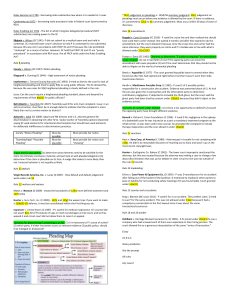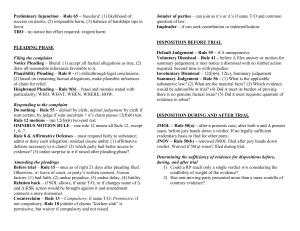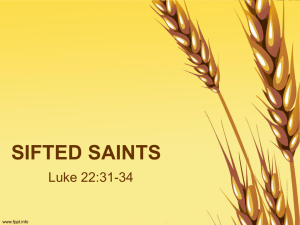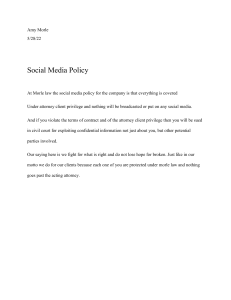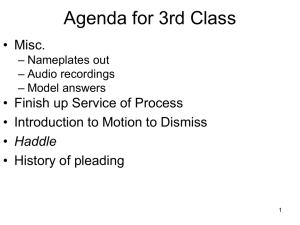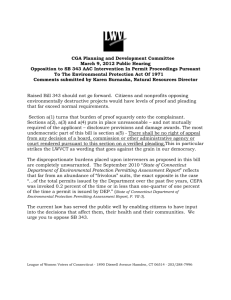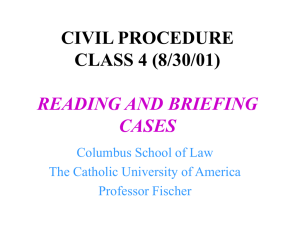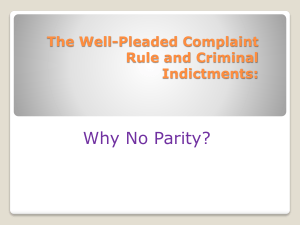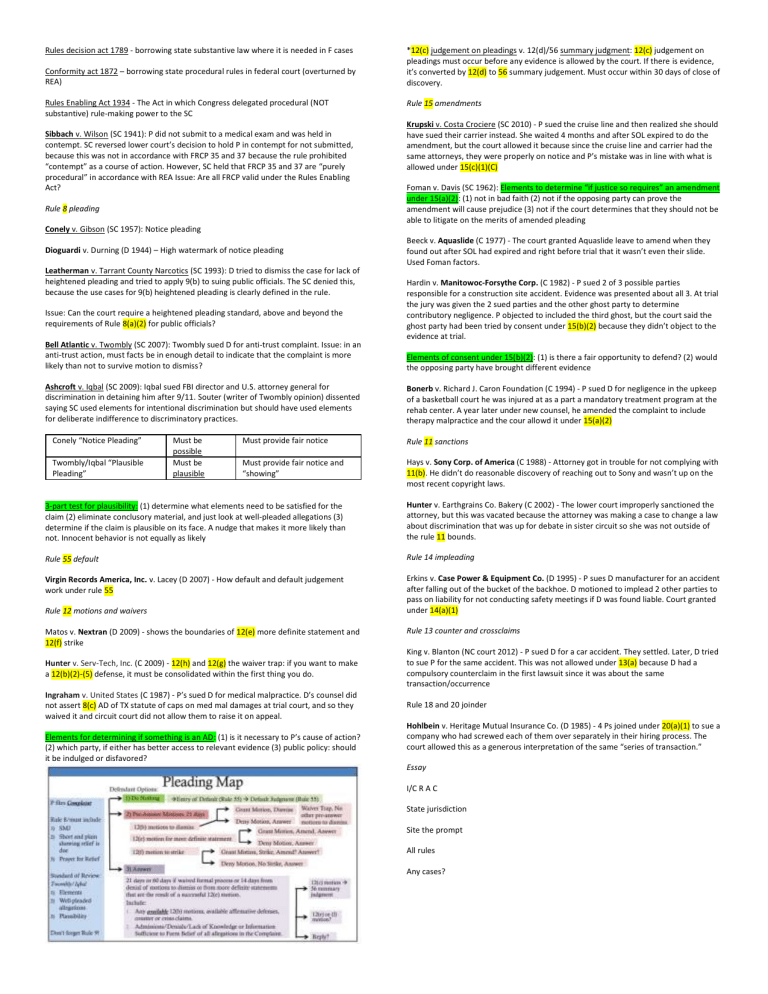
Rules decision act 1789 - borrowing state substantive law where it is needed in F cases Conformity act 1872 – borrowing state procedural rules in federal court (overturned by REA) Rules Enabling Act 1934 - The Act in which Congress delegated procedural (NOT substantive) rule-making power to the SC Sibbach v. Wilson (SC 1941): P did not submit to a medical exam and was held in contempt. SC reversed lower court’s decision to hold P in contempt for not submitted, because this was not in accordance with FRCP 35 and 37 because the rule prohibited “contempt” as a course of action. However, SC held that FRCP 35 and 37 are “purely procedural” in accordance with REA Issue: Are all FRCP valid under the Rules Enabling Act? Rule 8 pleading *12(c) judgement on pleadings v. 12(d)/56 summary judgment: 12(c) judgement on pleadings must occur before any evidence is allowed by the court. If there is evidence, it’s converted by 12(d) to 56 summary judgement. Must occur within 30 days of close of discovery. Rule 15 amendments Krupski v. Costa Crociere (SC 2010) - P sued the cruise line and then realized she should have sued their carrier instead. She waited 4 months and after SOL expired to do the amendment, but the court allowed it because since the cruise line and carrier had the same attorneys, they were properly on notice and P’s mistake was in line with what is allowed under 15(c)(1)(C) Foman v. Davis (SC 1962): Elements to determine “if justice so requires” an amendment under 15(a)(2): (1) not in bad faith (2) not if the opposing party can prove the amendment will cause prejudice (3) not if the court determines that they should not be able to litigate on the merits of amended pleading Conely v. Gibson (SC 1957): Notice pleading Dioguardi v. Durning (D 1944) – High watermark of notice pleading Leatherman v. Tarrant County Narcotics (SC 1993): D tried to dismiss the case for lack of heightened pleading and tried to apply 9(b) to suing public officials. The SC denied this, because the use cases for 9(b) heightened pleading is clearly defined in the rule. Issue: Can the court require a heightened pleading standard, above and beyond the requirements of Rule 8(a)(2) for public officials? Bell Atlantic v. Twombly (SC 2007): Twombly sued D for anti-trust complaint. Issue: in an anti-trust action, must facts be in enough detail to indicate that the complaint is more likely than not to survive motion to dismiss? Ashcroft v. Iqbal (SC 2009): Iqbal sued FBI director and U.S. attorney general for discrimination in detaining him after 9/11. Souter (writer of Twombly opinion) dissented saying SC used elements for intentional discrimination but should have used elements for deliberate indifference to discriminatory practices. Conely “Notice Pleading” Hardin v. Manitowoc-Forsythe Corp. (C 1982) - P sued 2 of 3 possible parties responsible for a construction site accident. Evidence was presented about all 3. At trial the jury was given the 2 sued parties and the other ghost party to determine contributory negligence. P objected to included the third ghost, but the court said the ghost party had been tried by consent under 15(b)(2) because they didn’t object to the evidence at trial. Elements of consent under 15(b)(2): (1) is there a fair opportunity to defend? (2) would the opposing party have brought different evidence Bonerb v. Richard J. Caron Foundation (C 1994) - P sued D for negligence in the upkeep of a basketball court he was injured at as a part a mandatory treatment program at the rehab center. A year later under new counsel, he amended the complaint to include therapy malpractice and the cour allowd it under 15(a)(2) Must provide fair notice Rule 11 sanctions Must provide fair notice and “showing” Hays v. Sony Corp. of America (C 1988) - Attorney got in trouble for not complying with 11(b). He didn’t do reasonable discovery of reaching out to Sony and wasn’t up on the most recent copyright laws. 3-part test for plausibility: (1) determine what elements need to be satisfied for the claim (2) eliminate conclusory material, and just look at well-pleaded allegations (3) determine if the claim is plausible on its face. A nudge that makes it more likely than not. Innocent behavior is not equally as likely Hunter v. Earthgrains Co. Bakery (C 2002) - The lower court improperly sanctioned the attorney, but this was vacated because the attorney was making a case to change a law about discrimination that was up for debate in sister circuit so she was not outside of the rule 11 bounds. Rule 55 default Rule 14 impleading Virgin Records America, Inc. v. Lacey (D 2007) - How default and default judgement work under rule 55 Erkins v. Case Power & Equipment Co. (D 1995) - P sues D manufacturer for an accident after falling out of the bucket of the backhoe. D motioned to implead 2 other parties to pass on liability for not conducting safety meetings if D was found liable. Court granted under 14(a)(1) Twombly/Iqbal “Plausible Pleading” Must be possible Must be plausible Beeck v. Aquaslide (C 1977) - The court granted Aquaslide leave to amend when they found out after SOL had expired and right before trial that it wasn’t even their slide. Used Foman factors. Rule 12 motions and waivers Matos v. Nextran (D 2009) - shows the boundaries of 12(e) more definite statement and 12(f) strike Rule 13 counter and crossclaims Hunter v. Serv-Tech, Inc. (C 2009) - 12(h) and 12(g) the waiver trap: if you want to make a 12(b)(2)-(5) defense, it must be consolidated within the first thing you do. King v. Blanton (NC court 2012) - P sued D for a car accident. They settled. Later, D tried to sue P for the same accident. This was not allowed under 13(a) because D had a compulsory counterclaim in the first lawsuit since it was about the same transaction/occurrence Ingraham v. United States (C 1987) - P’s sued D for medical malpractice. D’s counsel did not assert 8(c) AD of TX statute of caps on med mal damages at trial court, and so they waived it and circuit court did not allow them to raise it on appeal. Rule 18 and 20 joinder Elements for determining if something is an AD: (1) is it necessary to P’s cause of action? (2) which party, if either has better access to relevant evidence (3) public policy: should it be indulged or disfavored? Hohlbein v. Heritage Mutual Insurance Co. (D 1985) - 4 Ps joined under 20(a)(1) to sue a company who had screwed each of them over separately in their hiring process. The court allowed this as a generous interpretation of the same “series of transaction.” Essay I/C R A C State jurisdiction Site the prompt All rules Any cases?
